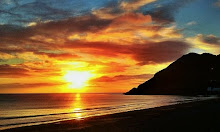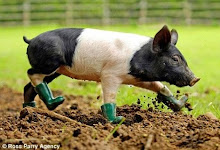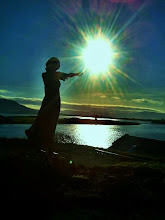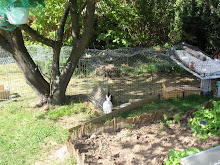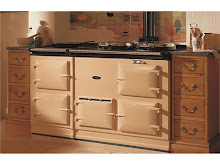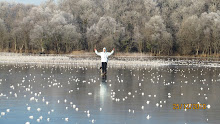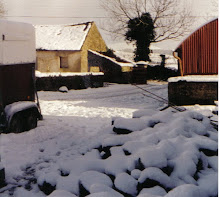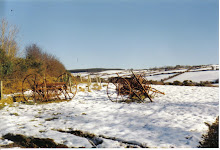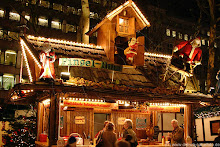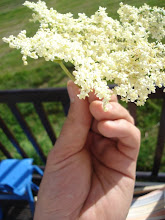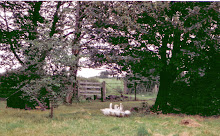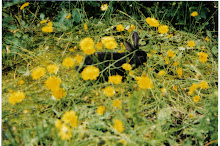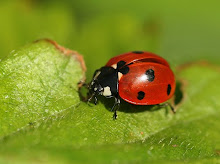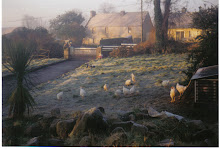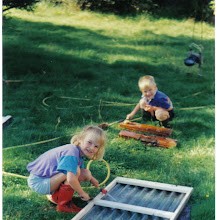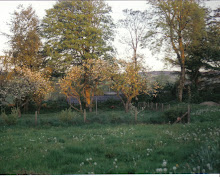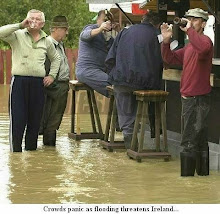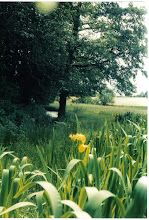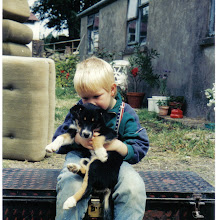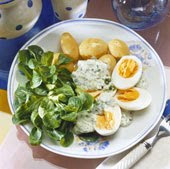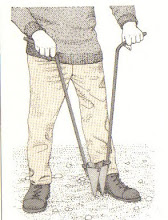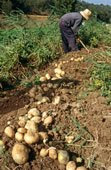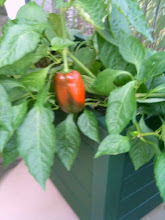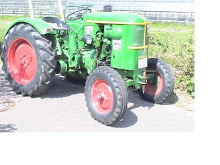We viewed farms that seemed to have good land and where the price was right. Talking to locals and neighbors became an eye-opener. Over a pint of Guinness, we stumbled over little secrets not mentioned in the advertisements. A mansion in Co. Wicklow was appealing to the eye with huge ballroom sized bedrooms, high stucco ceilings, and chandeliers. It had a beautiful, curving staircase with mahogany banisters to slide down on. The caretaker refused to accompany us in and show it from the inside, because it had a ghost. That, however, only increased its appeal to my Ex, “Think of its touristy value!” It gave me the creeps. The Irish are fond of ghosts, leprechauns, Little People, and other manifestations of the Irish spirit. The local banker confirmed the ghost’s existence. However, during the conversation he let slip that some acreage was useless due to flooding in the spring just when one wants to sow.
My Ex fell in love with a place situated on a lake that had its own mill, forge, and power station. It also had about 15 rooms, some cracked windowpanes and miles of gutters that needed replacing. While it would have been an opportunity to run the house as a Bed & Breakfast in addition to the farming enterprise, I could visualize Himself pottering about fixing the place up for years to come. I pointed out the costs for central heating. Oh, there wasn’t any yet, we could install it gradually. Thankfully, this particular gem of real estate – like most property in Ireland − was sold by auction and we were outbid.
Farms high up on hills were too windswept for certain crops and vulnerable in storms. Others had big and functioning outbuildings but the yards were too mucky for my taste.
At the end of our second reconnaissance trip, after an exhausting day and almost disillusioned, we found what we were looking for. The farm was located in a beauty spot near Lough Derg in Co. Tipperary, also within easy reach of Limerick, a university town, and Shannon Airport. From here tourists start their boat trips on the lake up the Shannon. Situated on a small hill, a pink house nestled under protective old trees, mostly beech and ash, and it had a very clean yard. I didn’t get out of the car because my 10 month old was asleep on my lap. “Check it out what it’s like inside and I can settle for it.”
The price was right and it could be rented to interested neighbors until we were to make the big final move. Until then the property yielded a good return on our investment and we could use it for vacations. Take a glimpse: (http://www.irelandinpicture.net/2009/05/boreens-and-backroads.html). It resembles our little boreen, down to hedgerows of flowering whitethorn and grass growing in the middle of the road.
Now we had a farm but we weren’t yet farmers. Not just yet.
Sunday, September 27, 2009
Friday, September 25, 2009
Location, Location, Location
As any realtor will tell you, this is not a troll’s truism regardless of what type of property you are looking for. Searching for a suitable piece of land, our choice was influenced by a couple of criteria. For my Ex, the soon to be farmer, it was the quality of the land. For me it was the accessibility. Obviously farms are in rural areas and this city girl wanted to be within a reasonable driving distance of a city, schools, and airport, not totally in the sticks. For the farmer, it had to be good arable land which is considered to be suitable for any type of farming whatever you go into. We were looking for more than the aforementioned 5 acres, which according to the Seymour-Bible, were enough to sustain a family.
Soil conditions in Ireland vary considerably. The midlands have the richest, most fertile conditions. This is the region to grow grains, an indicator for its quality. Farm prices reflected this fact. The further north you go (Clare, Galway, Sligo, or westwards towards Kerry) the land becomes stonier and less suitable for multipurpose agriculture. While the countryside is beautiful with its dry stone walls, i.e. without mortar, the ground becomes stonier too. The walls, by the way, were erected by laborers in previous centuries that picked up the stones from the fields. They stacked them up into walls that created fences and boundaries around fields. Labor was cheap in those days.
We traveled pretty much all over the country, starting off on the East coast in Dublin. Heading west, the rolling countryside of Co. Kildare, home to stud farms, was very lush but unaffordable. Farm value is calculated per acre. If there is a house on it, it’s thrown into the bargain. So it was an extra bonus if the house was livable or even in move-in condition.
Soil conditions in Ireland vary considerably. The midlands have the richest, most fertile conditions. This is the region to grow grains, an indicator for its quality. Farm prices reflected this fact. The further north you go (Clare, Galway, Sligo, or westwards towards Kerry) the land becomes stonier and less suitable for multipurpose agriculture. While the countryside is beautiful with its dry stone walls, i.e. without mortar, the ground becomes stonier too. The walls, by the way, were erected by laborers in previous centuries that picked up the stones from the fields. They stacked them up into walls that created fences and boundaries around fields. Labor was cheap in those days.
We traveled pretty much all over the country, starting off on the East coast in Dublin. Heading west, the rolling countryside of Co. Kildare, home to stud farms, was very lush but unaffordable. Farm value is calculated per acre. If there is a house on it, it’s thrown into the bargain. So it was an extra bonus if the house was livable or even in move-in condition.
Wednesday, September 23, 2009
A sneak peek of topics
What you will find here in the next few weeks about our endeavors:
-Location: how to choose your land wisely; water supply; fencing
-grow veggies in crop rotation: cauliflower, tomatoes, potatoes, onions, carrots, eggplants, cucumbers
-raising and plucking chickens and geese; organic feeds
-dealing with weeds and pests
-composting; kindling and firewood; making hay
-calves, calving, lambing
-AI (Artficial insemination); children and the facts of life
-making preserves, jams and tomato ketchup; freezing
-dealing with abundance
-growing mushrooms
-homebrew; baking bread
-recycling, and many more topics as they come up.
I will not endeavor to teach you how to harness a horse, milk a cow, slaughter an ox, cure a ham, salt beef, brew beer, churn butter, press cheese, keep bees, track game, set a snare, bat a hook, skin a rabbit, sink a well, build a barn, mend a wall, fire bricks, dress stone, spin flax, coil pots, weave a basket, thatch a roof, construct an oven make fuel, generate light, harness the wind. We didn't get round to that! (All of that can be studied in Seymour's books), but "follow the seasons, respect the land, reap the harvest, waste nothing, stay healthy and live well."
“We are intended by nature to be diverse, to do diverse things, to have many skills.” (John Seymour). So get ready.
-Location: how to choose your land wisely; water supply; fencing
-grow veggies in crop rotation: cauliflower, tomatoes, potatoes, onions, carrots, eggplants, cucumbers
-raising and plucking chickens and geese; organic feeds
-dealing with weeds and pests
-composting; kindling and firewood; making hay
-calves, calving, lambing
-AI (Artficial insemination); children and the facts of life
-making preserves, jams and tomato ketchup; freezing
-dealing with abundance
-growing mushrooms
-homebrew; baking bread
-recycling, and many more topics as they come up.
I will not endeavor to teach you how to harness a horse, milk a cow, slaughter an ox, cure a ham, salt beef, brew beer, churn butter, press cheese, keep bees, track game, set a snare, bat a hook, skin a rabbit, sink a well, build a barn, mend a wall, fire bricks, dress stone, spin flax, coil pots, weave a basket, thatch a roof, construct an oven make fuel, generate light, harness the wind. We didn't get round to that! (All of that can be studied in Seymour's books), but "follow the seasons, respect the land, reap the harvest, waste nothing, stay healthy and live well."
“We are intended by nature to be diverse, to do diverse things, to have many skills.” (John Seymour). So get ready.
Friday, September 18, 2009
Getting started
Coming from a city in Western Germany, my big concern was that self-sufficiency –farming meant going back to a lower standard of life. The idea and my ex’s expectation, however, was that it enhanced it: by growing and consuming our own produce, by harvesting the fruit of our land and hands. We didn’t know that it would also take up most of our waking hours and continuously occupy our thoughts caring and worrying about animals that depend on you; that even the weather would become a major concern to us.
In Ireland, they called us organics, alternative life-stylers ‘the Birkenstock wearing , muesli munching crowd.’ Wellies or Wellington boots were more practical though, given the climate conditions.
Before you make the big move and opt out of the rat race and become a back –to- the-lander, you may want to experiment and practice a little on a smaller scale. Convert a big ornamental planter into your first herb garden, dig up a patch of lawn at the end of your back yard (the front stretch might offend your neighbors), convert a flowerbed into a vegetable patch, or turn a piece of ugly waste land near the garden shed into something productive. Allotments used to be popular in the olden days, often of economic hardship and as a getaway for city dwellers.
If you live in suburbia, as I do now, you should check with your CDD or HOA. I’ve seen rooftops verdant with beanstalks, zucchinis, and tomatoes. You want to check the weight capacity of your roof though. If you really want to grow your own, you’ll find a way. When we bought our farm in the West of Ireland in the 80s, our cattle raising and dairy producing neighbor proudly announced, “We don’t have to go to all that trouble anymore. We used to do that when we were poor. Now we can buy fruit and vegetables in the shop.” I’m proud to say, within 2 years of watching us, she had parsley and strawberries going successfully.
In Ireland, they called us organics, alternative life-stylers ‘the Birkenstock wearing , muesli munching crowd.’ Wellies or Wellington boots were more practical though, given the climate conditions.
Before you make the big move and opt out of the rat race and become a back –to- the-lander, you may want to experiment and practice a little on a smaller scale. Convert a big ornamental planter into your first herb garden, dig up a patch of lawn at the end of your back yard (the front stretch might offend your neighbors), convert a flowerbed into a vegetable patch, or turn a piece of ugly waste land near the garden shed into something productive. Allotments used to be popular in the olden days, often of economic hardship and as a getaway for city dwellers.
If you live in suburbia, as I do now, you should check with your CDD or HOA. I’ve seen rooftops verdant with beanstalks, zucchinis, and tomatoes. You want to check the weight capacity of your roof though. If you really want to grow your own, you’ll find a way. When we bought our farm in the West of Ireland in the 80s, our cattle raising and dairy producing neighbor proudly announced, “We don’t have to go to all that trouble anymore. We used to do that when we were poor. Now we can buy fruit and vegetables in the shop.” I’m proud to say, within 2 years of watching us, she had parsley and strawberries going successfully.
Thursday, September 17, 2009
The self-sufficiency guru
John Seymour, the guru of self-sufficiency, was then a man in his 70s when we stumbled across his books that changed our lives. On one of his trips between Germany and Ireland, hauling over some farm machinery, my Ex visited John on his farm in Killowen, Co. Wexford and had tea with him. He came back impressed about the set-up, how well it worked, how relaxed and unpretentious the old gentleman was, etc. What impressed him most, I guess, was the fact that John had a girl-friend/partner who was at least 30 years his junior. Hence his fervour for organic farming? Who was first, the chicken or the egg?
Wednesday, September 16, 2009
I once had a Farm in Ireland
Memories of that previous life are still vivid in my head as if it was yesterday, although not in cinematographic ochre and amber but all shades of green. Ireland is high on the list of many tourists who wish to visit it for its scenery, folklore, and the “Million Welcomes” of its people. It is also the country many Americans trace their roots back to and longingly dream of. Farming is a life style and never ending work. Farming can be somebody’s dream –as it was for my ex− and the nightmare of others.
Interested in farming, producing your own produce and foods, and an alternative lifestyle? This column of an ex- farmer’s wife (or is it farmer’s ex wife?) can shine some light on life on the farm through anecdotes of her previous experience introducing organic farming to rural Ireland.
We’re talking Irish farms here, not American multi thousand acre agricultural operations. We’re talking self-sufficiency. Ours had 127 acres. (For city dwellers: 1 acre=4,840 sq. yd.) For Irish and organic farming standards this is a big chunk of land.
How does one get into it? Either you inherit it or dream of living “the good life”. With the current recession, job losses, and stock and property markets crash investment advisors these days recommend to invest into gold and diamonds – or farming. At least grow your own vegetables.
In my case it was the danger of another environmental disaster after Chernobyl in 1986, and the nuclear threat was motivation enough for us to opt out of the rat race and get started. After Chernobyl, in Germany fall out levels were dangerously high. The government discouraged people to feed milk to their children, and our new Geiger counter measured excessive radiation levels in our children’s sandbox. Ireland had escaped almost unscathed due to the prevailing weather pattern in the 2 weeks after the disaster in Ukraine. That was it for us. If some of this sounds vaguely familiar to you and resonates with current developments in an increasingly environmentally challenged and endangered world, you may want to read on.
Another driving factor was a book that topped the bestseller list in Germany in 1980: John Seymour, Self-sufficiency on the Farm: The classic guide for realists and dreamers. It became our bible. My ex had no background in farming. He learned what he needed to know from this story-book look-alike that contains specific instructions and cute drawings. Invaluable advice also came from a friendly elderly neighbor, a life-long farm laborer who scratched his head watching our humble attempts at farming.
So here’s what you need: a little nest egg, or preferably a biggish pocket book, or better still an inheritance to buy yourself into farming , Seymour’s book maybe, and enthusiasm; in fact tons of it. Throw in a dose of practical realism with your dreams and you can farm away.
According to this bible, you need about 5 acres. Small is not only beautiful but is also viable. If you can still lay your hands on a copy: (New-Complete-Book-Self-Sufficiency). Also see Seymour’s Killowen Smallholding project at http://www.self-sufficiency.net).
With farming you step back in time; something that a shopper at popular farmers’ markets doesn’t necessarily realize. A life close to nature awaits you. You work with your hands, are exposed to the elements, and you bond with your animals, as well as your neighbors whose help and advice you’ll learn to cherish. You synchronize your life with the sun −some even with the moon (http://www.biodynamics.com/biodynamics.html). You will experience life and death from close up and will value clement weather and the peace that surrounds you. Coming from Western Germany, the sticks of Ireland were a huge change and culture shock for me. In spite of recent the mega changes occurring in Ireland commercially, also known as the heydays of the Celtic Tiger, rural Ireland remains widely untouched.
Farming keeps you on your toes around the clock –literally. We only achieved part of Seymour’s self-sufficiency (and skipped the tool and furniture making): We farmed, grew our own vegetables −more than we could eat. You can grow everything yourself, weather and climate permitting. Having previously cut our meat consumption to a minimum whilst living in the city, we raised our own meat. Organic food in the early 80s was still in its infancy and buying it not really an option. On the farm we had chickens, geese, pigs, and cows. Naturally organic. Otherwise we couldn’t be bothered and it is the more viable option to make the enterprise profitable. I baked our own bread and cakes- after grinding the wheat.
For almost 10 years, we nearly killed ourselves producing healthy food.
Interested in farming, producing your own produce and foods, and an alternative lifestyle? This column of an ex- farmer’s wife (or is it farmer’s ex wife?) can shine some light on life on the farm through anecdotes of her previous experience introducing organic farming to rural Ireland.
We’re talking Irish farms here, not American multi thousand acre agricultural operations. We’re talking self-sufficiency. Ours had 127 acres. (For city dwellers: 1 acre=4,840 sq. yd.) For Irish and organic farming standards this is a big chunk of land.
How does one get into it? Either you inherit it or dream of living “the good life”. With the current recession, job losses, and stock and property markets crash investment advisors these days recommend to invest into gold and diamonds – or farming. At least grow your own vegetables.
In my case it was the danger of another environmental disaster after Chernobyl in 1986, and the nuclear threat was motivation enough for us to opt out of the rat race and get started. After Chernobyl, in Germany fall out levels were dangerously high. The government discouraged people to feed milk to their children, and our new Geiger counter measured excessive radiation levels in our children’s sandbox. Ireland had escaped almost unscathed due to the prevailing weather pattern in the 2 weeks after the disaster in Ukraine. That was it for us. If some of this sounds vaguely familiar to you and resonates with current developments in an increasingly environmentally challenged and endangered world, you may want to read on.
Another driving factor was a book that topped the bestseller list in Germany in 1980: John Seymour, Self-sufficiency on the Farm: The classic guide for realists and dreamers. It became our bible. My ex had no background in farming. He learned what he needed to know from this story-book look-alike that contains specific instructions and cute drawings. Invaluable advice also came from a friendly elderly neighbor, a life-long farm laborer who scratched his head watching our humble attempts at farming.
So here’s what you need: a little nest egg, or preferably a biggish pocket book, or better still an inheritance to buy yourself into farming , Seymour’s book maybe, and enthusiasm; in fact tons of it. Throw in a dose of practical realism with your dreams and you can farm away.
According to this bible, you need about 5 acres. Small is not only beautiful but is also viable. If you can still lay your hands on a copy: (New-Complete-Book-Self-Sufficiency). Also see Seymour’s Killowen Smallholding project at http://www.self-sufficiency.net).
With farming you step back in time; something that a shopper at popular farmers’ markets doesn’t necessarily realize. A life close to nature awaits you. You work with your hands, are exposed to the elements, and you bond with your animals, as well as your neighbors whose help and advice you’ll learn to cherish. You synchronize your life with the sun −some even with the moon (http://www.biodynamics.com/biodynamics.html). You will experience life and death from close up and will value clement weather and the peace that surrounds you. Coming from Western Germany, the sticks of Ireland were a huge change and culture shock for me. In spite of recent the mega changes occurring in Ireland commercially, also known as the heydays of the Celtic Tiger, rural Ireland remains widely untouched.
Farming keeps you on your toes around the clock –literally. We only achieved part of Seymour’s self-sufficiency (and skipped the tool and furniture making): We farmed, grew our own vegetables −more than we could eat. You can grow everything yourself, weather and climate permitting. Having previously cut our meat consumption to a minimum whilst living in the city, we raised our own meat. Organic food in the early 80s was still in its infancy and buying it not really an option. On the farm we had chickens, geese, pigs, and cows. Naturally organic. Otherwise we couldn’t be bothered and it is the more viable option to make the enterprise profitable. I baked our own bread and cakes- after grinding the wheat.
For almost 10 years, we nearly killed ourselves producing healthy food.
Subscribe to:
Posts (Atom)
